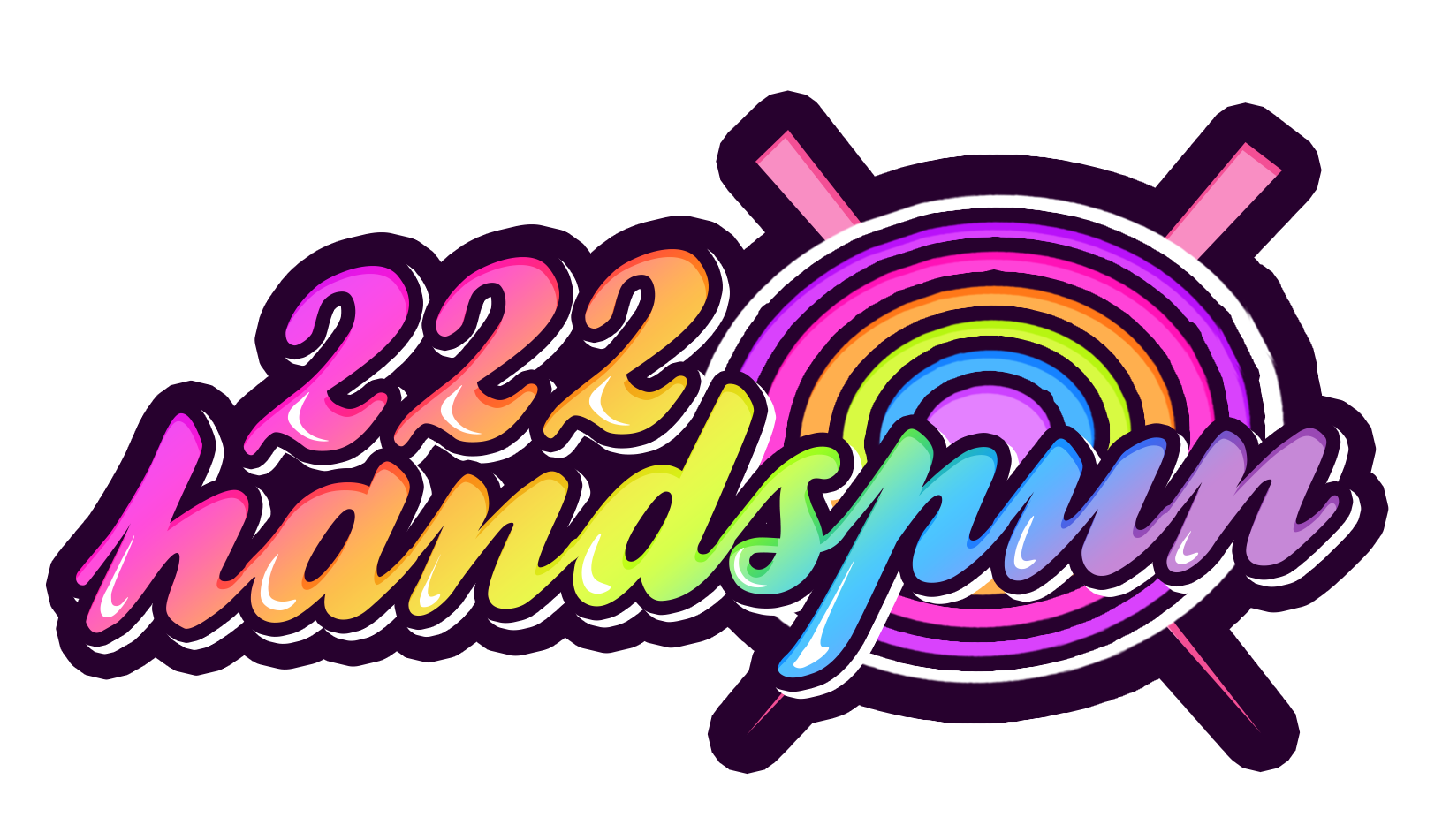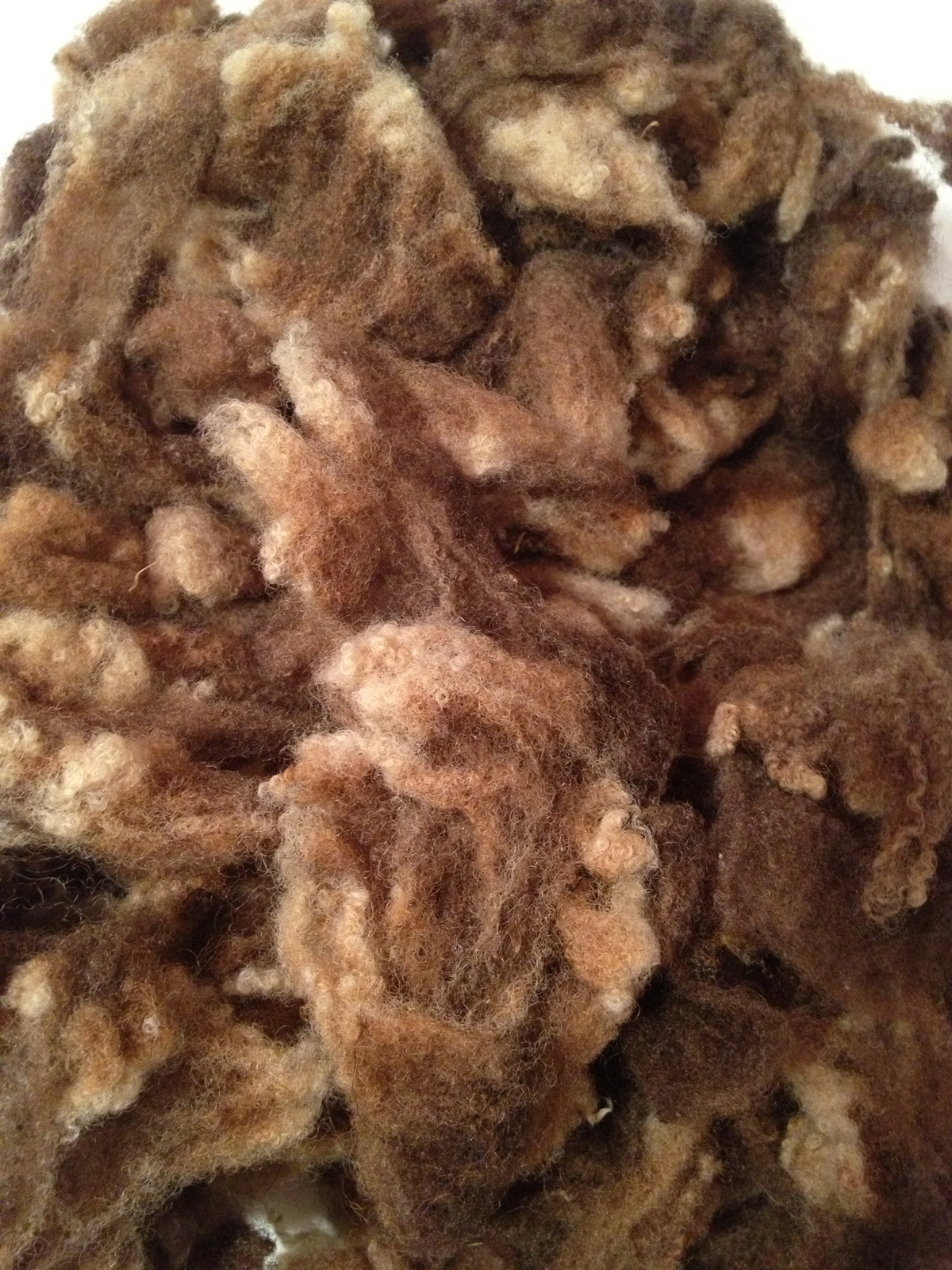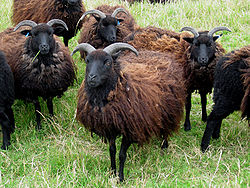Breed Study: Primitive Breeds (UK) - September 2013
Primitive Breeds (UK) September 2013 Breed Box from Namaste Farms
My continuing exploration of sheep's wool from various breeds around the world following along with the Fleece and Fiber Sourcebook. I've been purchasing Breed Boxes from Namaste Farms and enjoy listening to Natalie's informative discussions of the featured breeds with Martin Dally on Namaste Farm's BlogTalkRadio cast. Each breedbox is shipped blind, so you have to wait to find out what breeds the samples are from.
I apologize for the crappy iPhone pics of the fiber. This month's breeds are:
A) Icelandic (USA grown)
This changed my mind a little bit about Icelandic wool. I've spun Icelandic top before and it was a super pain to work with. I've heard it's great for felting though. These samples were OK when you separate out the long outer coat called tog from the fine inner coat called thel. While listening to the BlogTalkRadio cast, Martin instructed listeners to pull the tippy end to separate the hair from the more downy wool underneath. The tog is about 2x the length of the softer thel staple. There is definitely a big difference in texture and a nice soft undercoat.
Description of the breed from Namaste Farms:
The Icelandic sheep is one of the world’s oldest and purest breeds of sheep. Throughout its 1100 years of history, the Icelandic breed has been truly triple-purpose, treasured for its meat, fiber and milk.
The Icelandic breed is in the North European short-tailed group of sheep, which exhibits a fluke-shaped, naturally short tail. To ensure the continuing purity of the breed, tail docking an Icelandic will disqualify it from being registered in North America. Icelandics are a mid-sized breed with ewes averaging 130-160 pounds, and rams averaging 180-220 pounds. Conformation is generally short legged and stocky. The face and legs are free of wool. The fleece is dual-coated and comes in white as well as a range of browns, grays and blacks. There are both horned and polled strains. Left unshorn for the winter, the breed is very cold hardy.
The most eye-catching aspect of the breed is the variation of colors and patterns. Genetically, Icelandics have one of two base colors, either black or moorit (brown). They exhibit 5 pattern combinations: white, gray, badgerface, mouflon and solid. Individual sheep may also display various shades of these colors/patterns, ranging from white, cream, light gray, tan, caramel, milk chocolate, silver, dark chocolate, dark gray, to jet black. A spotting gene adds even more combinations with many recognized and named patterns of white markings.
The Icelandic sheep produces a premium fleece. The fleece is dual coated, with a fine, soft undercoat called thel and a longer, coarser outer coat called tog. The tog fiber with a spinning count of 56-60 and a micron count of 27-30, grows to a length of 6-8″ in six months. It is lustrous, strong, water- and wear-resistant, and sheds off the rain and weather. Thel is the soft downy undercoat, with a spinning count of 64-70 and a micron count of 19-22, growing to a length of 2-4″. The thel provides the loft for the outer coat and insulation for the sheep. Tog grows from the primary hair follicles and the thel from the secondary follicles. Tog is a true wool, and is not a kemp or guard hair. The combination of the two fibers on the sheep gives superb protection from the cold and wet.
Icelandic fleeces are open and low in lanolin. The weight loss when washed is significantly less than many other breeds.
The average adult yearly fleece total weighs 4-7 lbs. Producers often shear their Icelandics twice a year. This is due, in part, to the fact that Icelandics have a natural wool break in late winter for the rams generally, and in spring for the pregnant or lactating ewes. Shearing at or around the time of the natural break is recommended to remove the “old” coat before the “new” coat grows in. The sheep are sheared again in the fall to harvest the fleeces before the animals go on hay for the winter. These fall-shorn fleeces are very soft and clean and can bring a premium price per pound.
The two coats can be separated by hand for special projects, or they may be processed together. The traditional lopi is a lightly spun blend of tog and thel. Thel is very soft and downy, with an irregular crimp and can be used for baby garments, and for the fine shawls in the style of the Wedding Shawl. The tog is similar to mohair; wavy or corkscrewed rather than crimped and is wonderful in worsted spinning.
The versatility of the wool, the ease of spinning and the wide variation of tones and colors are a true delight to handspinners, and put Icelandic wool into the exotic or premium category. It is also known as one of the best fleeces for felting, which is fast gaining popularity in the craft community. Photos and info from http://www.isbona.com/icelandicsheep.html
Average Fiber Diameter in Microns: 27-31 (outercoat); 19-22 (undercoat)
Grease Fleece Weight 4-7 lbs
Staple: 4-18 in (outercoat); 2-4 in (undercoat)
Yield = 50-90%
(Fleece and Fiber Sourcebook)
Icelandic sheep (Wikipedia)
Washed Icelandic Fleece © 222 Handspun
B) Shetland
I was surprised by these samples. There are a couple different types - Double Coated and Single Coated. It was the Doubled coated that threw me off because at first glance I thought it was Icelandic. It looks so similar, but on closer examination it is actually much softer and more of what I'm used to seeing.
Description of the breed from Namaste Farms:
The Shetland’s roots go back over a thousand years, probably to sheep brought to the Shetland Islands by Viking settlers. They belong to the Northern European short-tailed group of sheep, which also includes Finn sheep, Icelandic sheep, and Romanovs. The Shetland is a primitive, unimproved breed noted for its natural hardiness, lambing ease, longevity, and ability to survive under harsh conditions. It is one of the smallest breeds of sheep.
Shetlands are known primarily for their production of colorful wool upon which the Shetland woolen industry is based. Shetland comes in one of the widest ranges of colors of any breed. There are 11 main colors as well as 30 markings, many still bearing their Shetland dialect names. Shetlands naturally shed their wool during late spring/early summer. http://www.sheep101.info/breedsS.html#Shetland
However, one of the marvelous aspects of the Shetland is its variability within the breed. A small spinner’s flock can produce ultra-fine Shetland yarn for handknits as well as coarser, but equally gorgeous yarns suitable for sturdy socks and warm outer garments and remarkable tapestry yarns.
Shetland wool comes in one of the widest ranges of colors of any breed. Everything from the purest white to the deepest coal black. There are 11 main colors and 30 markings, many still bearing their Shetland dialect names. Unfortunately, many of these colors and markings have become rare as white wool is dominant and for the last two hundred years has been preferred by commercial mills. http://www.shetland-sheep.org/about-shetlands/shetland-wool/
Shetland sheep have for generations been noted for their very soft and well crimped fleece. The wool is the finest of all native breeds and shows an amazing variety of colours and markings. There are 11 main whole colours and 30 recognised markings. By selecting from coloured fleeces a range of naturally coloured yarn can be produced. This eliminates the need for dyeing and therefore retains the soft feel of the natural fibre and is favoured by those who prefer a totally natural approach.
Shetland wool fibres are of a simple construction with a central cortex covered by a thin scaly cuticle, and have an average diameter of about 23 microns. However there is a range from 10 to 20 microns for neck and shoulder wool to 25 to 35 microns for britch wool. The average staple length is 3.5 inches. The amount of crimp varies, and is important in providing the ‘bounce’ required for knitwear. There is a positive correlation between fineness and crimp, with wool of the finest quality being crimped at between 8 and 12 to the inch. Wool from Shetland sheep is used to produce gossamer lace, the famous ‘Fair isle’ knitwear, and fine tweeds.
Pure bred Shetland sheep tend to shed their fleece in spring. The growth of new fleece can cause a rise or weak point and where this is present the fleece can sometimes be plucked or ‘rooed’ by hand. The timing of this can be different in each sheep, however, it is worth taking the care to get it right as rooed fleece can be amongst the softest because the fibres have no harsh cut ends as occurs with a sheared fleece. http://www.shetland-sheep.org.uk
Average Fiber Diameter in Microns: range of 20-30
Grease Fleece Weight 2-5 lbs
Staple varies depending on type of Shetland: 2-4.5 in. in general; North American Shetlands have range of 4-6 in.; longer fleeces 6-7 in.
Yield = 65-80%
(Fleece and Fiber Sourcebook)
Shetland Sheep (from Wikipedia)
Washed Shetland Fleece © 222 Handspun
C) Manx Loaghtan
(pronounced "lock-tan")
This fleece has a very short staple length and almost appears to be a bunch of second cuts. I initially thought it was the Shetland fleece because the color and reminded me of a Shetland fleece I just purchased. It's very crimpy and the sample was fairly clean. It's a milk chocolate color with blonde sun damaged tips. It feels similar to a Jacob fleece. Surprisingly I like it a lot. I'm not sure why since it isn't the softest texture and probably not long enough to spin but there is something appealing about it anyway. I think I'm just partial to really crimpy locks. Anyway, I can't stop playing with it.
Description of the breed from Namaste Farms:
The Manx Loaghtan is a small primitive sheep, one of the rare breeds of sheep on the watch list of the Rare Breeds Survival Trust. The breed originates from the prehistoric short-tailed breeds of sheep found in isolated parts of North West Europe where they survived because they were not replaced by more developed breeds. Other breeds in this same group are Soay, Hebridean, Shetland, Boreray and North Ronaldsay.
Loaghtans and their relatives grazed the hills of the Isle of Man until the 18th century but by the 1950s numbers had declined to a handful. As a result of the work of enthusiasts on the Isle of Man and in England, numbers have steadily increased over the last 50 years. Continued success will ensure the Loaghtan has a future providing excellent quality meat and wool as a pure bred.
Originally, most of the sheep were white, however there were also many grey, some black and relatively few the “loaghtan” colour we see today. Loaghtan is the Manx word for the brown “moorit” colour of the fleece which is derived from two Manx words “lugh” meaning mouse and “dhoan” meaning brown, or from “lhosht dhoan” meaning burnt brown. Clothing made from this loaghtan coloured wool was highly prized and, as the numbers of the sheep declined, breeders selected sheep of the loaghtan colour. As the loaghtan colour is recessive to all other colours, it breeds true and so it was relatively simple to fix that colour as a characteristic of the breed. This is why the rich brown loaghtan colour is the only colour, with variations in shade depth, which survives today. www.manxloaghtansheep.com
Average Fiber Diameter in Microns: 27 (wooly type) – 33 (hairy type)
Grease Fleece Weight 3-5.5 lbs
Staple: 2.5-5 in.
Yield = not listed
(Fleece and Fiber Sourcebook)
Manx Loaghtan sheep Ramsey, Isle of Man (Wikipedia)
Washed Manx Loaghtan Fleece © 222 Handspun
D) Hebridean
OK, nothing remarkable here, but not bad overall. It has a nice black color and long staple length. It feels a bit like the Icelandic or a Karakul. I think it would make a good rug wool.
Description of the breed from Namaste Farms:
The Hebridean sheep is one of the primitive breeds comprising the Northern Short-Tailed group of sheep from northwestern Europe. These sheep are relatively small and fine boned, with black or dark brown wool. The face and legs are largely free of wool and are covered with glossy black hair. Both sexes commonly have two or more horns; but ewes may be polled or scurred and some may carry large woolly topknots. Ewes typically weigh 35-40kg and rams proportionately larger. The legs are slender and the feet are small, with hard, black horn. The body is relatively long. These sheep are slow maturing and are not inclined to carry excess condition; mature adults, even on good keep, rarely have a body condition score greater than 3.
Adult fleeces range from black to dark brown; fleece tips may become brown through sunbleaching. Lambs are born truly black; fleeces on many yearlings become quite brown before the first shearing. Some sheep go grey with age, particularly on the flanks and the coarse wool of the hindquarters. Lambs may be born with a white spot on the poll or elsewhere, but this generally disappears within a few weeks. Some animals have a double-coated fleece of fine underwool overlaid by coarser fibres. Some rams may carry a mane or a ruff of coarse wool. Fleeces may range from dense and coarse to fine and soft, with the average ewe fleece weighing about 1.5 kg and ram fleeces about 3-4 kg. The staple length is 3-37 cm, with any crimp varying from slight to moderate. Fibre micron count has been measured at between 33 and 38, which equates to a Bradford count of 45-50.
This is what Hebridean Sheep originally looked like. Over the years, relentless selection for 2 horned sheep, whilst producing some stunning animals for the show ring, has resulted in sheep like these becoming incredibly rare. Note particularly the original fleece type and colour distribution. At Wester Gladstone, we are desperately trying to keep the original type of sheep alive.Photo courtesy of Dr David Kinsman.
Hebrideans are descended from the old Scottish Shortwool or Dunface breed, a breed which came in all colours. The current Hebrideans are black as only black sheep were originally selected to form the new breed. Up until 30 or so years ago, the Rare Breeds Survival Trust still recognised white Hebrideans which turned up occasionally, but since then it has not been possible to register them. Even a white spot on an otherwise pure black Hebridean makes it ineligible for registration. (http://www.scothebs.co.uk/hebridean-sheep.html )
Average Fiber Diameter in Microns: 29-38
Grease Fleece Weight 3.5-5.5 lbs
Staple: 2-8 in.; generally 2-6 in.
Yield = not listed
(Fleece and Fiber Sourcebook)
Three-Horned Hebridean sheep (Wikipedia)
A flock of Hebridean sheep (Wikipedia)
Washed Hebridean Fleece © 222 Handspun









